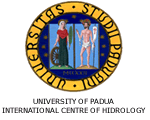


In collaboration with
Duke University (U.S.A.)
ESSC, Reading (U.K.)
ISAC-CNR, Turin (I)
MIT (U.S.A.)
University of Padua (I)
Biological and climate processes:
coupled dynamics and scales of interaction
Venice, June 11-18 2010
Istituto Veneto di Scienze Lettere ed Arti, Palazzo Cavalli Franchetti
Admitted Applicants
list
Deadline for application was 30 April, 2010
|
Conclusions |
|
28 participants were admitted out of a total of about 40 applications in this 2010 Biogeodynamics and Earth System Sciences Summer School. As a tradition inherited from previous summer schools cycles, the participants took part in substantial group work on research topics related to the lectures and seminars given during the School. Even though time is relatively short, the groups have laid the foundation for further work to be subsequently completed by group members, in several cases likely leading to publishable results. In particular, the following topics were tackled |
|
| Group 1 |
|
| Authors | Christina Karamperidou, Raffaele Ruggio |
| Advisor | Michael Ghil |
| Summary | The group focused on the use of BDE to represent the main features of ENSO occurrences, identifying suitable Boolean operators and possible insights in the statistical properties of ENSO manifestations. |
| Presentation | Boolean Delay Equations: Theory and Insights into the El Nino Southern Oscillation |
Group 2 |
|
| Authors | Rosana Aguilera Becker, Fereshteh Bagherimiyab, Silvia Terzago |
| Advisor | Michael Ghil |
| Summary | The group applied Singular Spectrum Analysis to the gap-filling and deseasonalization of temperature time series, identifying constraints on the length of the time series to which these tools can be applied. |
| Presentation | Spectral Methods in Time Series Analysis |
Group 3 |
|
| Authors | Bordiga Manuela, Carrara Francesco, Sciascia Roberta, Schiavina Marcello |
| Advisor | David Claessen |
| Summary | The group focused on the application of Adaptive Dynamics Theory to phytoplankton modelling. Different ecological models were considered, with different nutrient limitations and with/without predation. ADT allowed the construction of Pairwise Invasibility Plots and the identification of the stable equilibria over evolutionary time scales. |
| Presentation | Adaptive Dynamics Theory: case study of a NP model |
Group 4 |
|
| Authors | Mara Baudena, Emma Bee, Ethan Butler, Serena Ceola, Brian Dermody |
| Advisors | Gabriel Katul & Alexandra Konings |
| Summary | The group applied a Ricardo-Malthus approach to provide possible explanations to the collapse of Easter Island society. Model results, which included competition between agriculture and palm harvesting, was calibrated and compared with existing data on Easter Island population and activities. |
| Presentation | The Collapse of Easter Island |
Group 5 |
|
| Authors | Cristina Da Lio, Hugo de Boer, Caterina Francone, Nadia Ursino |
| Advisors | Gabriel Katul & Alexandra Konings |
| Summary | The group devised and implemented a coupled canopy exchange model for water vapor and CO2 and addressed the potential effects of elevated temperature and CO2 concentration values. |
| Presentation | Impact of water vapour feedback on canopy gas exchange under climate change |
Group 6 |
|
| Author | Valeria Volpe |
| Advisors | Gabriel Katul & Marco Marani |
| Summary | The group devised a new model of leaf-scale photosynthesis/gas exchange addressing and incorporating the effects of salinity on leaf physiology. The model was compared with existing literature data on water and CO2 exchanges under salinity and water stress conditions. |
| Presentation | Optimization theories for saline environments |
Group 7 |
|
| Authors | Pawlok Dass, Stefan Dekker, Robert Getzieh, Shaoxiu Ma, Davide Zoccatelli |
| Advisors | Gabriel Katul, Alexandra Konings & Stefan Dekker |
| Summary | The group coupled a slab atmospheric model to an interactive vegetation model to explore the statistical properties of space-time statistics of the equilibria associated to it. The group also explored the effects of more realistic representations of hydrologic processes (e.g. surface runoff) on the rainfall patterns produced by coupled atmosphere-vegetation models. |
| Presentation | Coupling Veg Pattern to ABL model |
Group 8 |
|
| Authors | Davide Donzelli, Bibiana Groppelli, Francisco Guerrero |
| Advisors | Daniel Rothman & Christopher Follett |
| Summary | The group applied the disordered kinetics approach to the description of heterogeneous kinetics in the degradation of aqueous organic matter in water bodies. The anallysis was performed on data from a river stream in Colombia and a swamp site in Malaysia. |
| Presentation | Transient decay of litterfall in a tropical fresh water ecosystem |
Partnership



